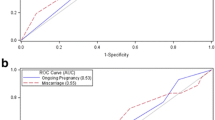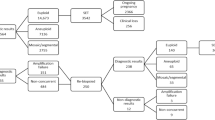Abstract
Preimplantation genetic testing for aneuploidy (PGT-A) is widely used in IVF and aims to improve outcomes by avoiding aneuploid embryo transfers. Chromosomal mosaicism is extremely common in early development and could affect the efficacy of PGT-A by causing incorrect embryo classification. Recent innovations have allowed accurate mosaicism detection in trophectoderm samples taken from blastocysts. However, there is little data concerning the impact of mosaicism on viability, and the optimal clinical pathway for such embryos is unclear. This study provides new information concerning the extent to which mosaic preimplantation embryos are capable of producing pregnancies and births. Archived trophectoderm biopsy specimens from transferred blastocysts were analyzed using next generation sequencing (NGS). Unlike other PGT-A methods, NGS accurately detects mosaicism in embryo biopsies. 44 mosaic blastocysts were identified. Their clinical outcomes were compared to 51 euploid blastocysts, derived from a well-matched, contemporary control group. Mosaic embryos were associated with outcomes that were significantly poorer than those of the control group: implantation 30.1 versus 55.8% (P = 0.038); miscarriage rate 55.6 versus 17.2% (P = 0.036); and ongoing pregnancy 15.4 versus 46.2% (P = 0.003). 61% of the mosaic errors affected whole chromosomes and 39% were segmental aneuploidies. Embryo viability is compromised by the presence of aneuploid cells. However, a minority of affected embryos can produce successful pregnancies. Hence, such embryos should not necessarily be excluded, but given a lower priority for transfer than those that are fully euploid. It is recommended that pregnancies established after mosaic embryo transfers be subjected to prenatal testing, with appropriate patient counselling.


Similar content being viewed by others
References
Capalbo A, Wright G, Elliott T, Ubaldi FM, Rienzi L, Nagy ZP (2013) FISH reanalysis of inner cell mass and trophectoderm samples of previously array-CGH screened blastocysts shows high accuracy of diagnosis and no major diagnostic impact of mosaicism at the blastocyst stage. Hum Reprod 28:2298–2307. doi:10.1093/humrep/det245
Coonen E, Derhaag JG, Dumoulin JC, van Wissen LC, Bras M, Janssen M, Evers JL, Geraedts JP (2004) Anaphase lagging mainly explains chromosomal mosaicism in human preimplantation embryos. Hum Reprod 19:316–324
Daphnis DD, Delhanty JD, Jerkovic S, Geyer J, Craft I, Harper JC (2005) Detailed FISH analysis of day 5 human embryos reveals the mechanisms leading to mosaic aneuploidy. Hum Reprod 20:129–137
Delhanty JD, Griffin DK, Handyside AH, Harper J, Atkinson GH, Pieters MH, Winston RM (1993) Detection of aneuploidy and chromosomal mosaicism in human embryos during preimplantation sex determination by fluorescent in situ hybridisation (FISH). Hum Mol Genet 2:1183–1185
Delhanty JD, Harper JC, Ao A, Handyside AH, Winston RM (1997) Multicolour FISH detects frequent chromosomal mosaicism and chaotic division in normal preimplantation embryos from fertile patients. Hum Genet 99:755–760
Evsikov S, Verlinsky Y (1998) Mosaicism in the inner cell mass of human blastocysts. Hum Reprod 13:3151–3155
Fiorentino F, Bono S, Biricik A, Nuccitelli A, Cotroneo E, Cottone G, Kokocinski F, Michel CE, Minasi MG, Greco E (2014) Application of next-generation sequencing technology for comprehensive aneuploidy screening of blastocysts in clinical preimplantation genetic screening cycles. Hum Reprod 29:2802–2813. doi:10.1093/humrep/deu277
Forman EJ, Hong KH, Ferry KM, Tao X, Taylor D, Levy B, Treff NR, Scott RT Jr (2013) In vitro fertilization with single euploid blastocyst transfer: a randomized controlled trial. Fertil Steril 100(100–7):e1. doi:10.1016/j.fertnstert.2013.02.056
Fragouli E, Lenzi M, Ross R, Katz-Jaffe M, Schoolcraft WB, Wells D (2008) Comprehensive molecular cytogenetic analysis of the human blastocyst stage. Hum Reprod 23:2596–2608. doi:10.1093/humrep/den287
Fragouli E, Alfarawati S, Daphnis DD, Goodall NN, Mania A, Griffiths T, Gordon A, Wells D (2011) Cytogenetic analysis of human blastocysts with the use of FISH, CGH and aCGH: scientific data and technical evaluation. Hum Reprod 26:480–490. doi:10.1093/humrep/deq344
Fragouli E, Alfarawati S, Spath K, Jaroudi S, Sarasa J, Enciso M, Wells D (2013) The origin and impact of embryonic aneuploidy. Hum Genet 321:1001–1013. doi:10.1007/s00439-013-1309-0
Fragouli E, Spath K, Alfarawati S, Kaper F, Craig A, Michel CE, Kokocinski F, Cohen J, Munne S, Wells D (2015) Altered levels of mitochondrial DNA are associated with female age, aneuploidy, and provide an independent measure of embryonic implantation potential. PLoS Genet 11:e1005241. doi:10.1371/journal.pgen.1005241
Greco E, Minasi MG, Fiorentino F (2015) Healthy babies after intrauterine transfer of mosaic aneuploid blastocysts. N Engl J Med 373:2089–2090. doi:10.1056/NEJMc1500421
Hassold T, Hunt P (2001) To err (meiotically) is human: the genesis of human aneuploidy. Nat Rev Genet 2:280–291
Hassold T, Hall H, Hunt P (2007) The origin of human aneuploidy: where we have been, where we are going. Hum Mol Genet 16:R203–R208
Konstantinidis M, Prates R, Goodall NN, Fischer J, Tecson V, Lemma T, Chu B, Jordan A, Armenti E, Wells D, Munné S (2015) Live births following Karyomapping of human blastocysts: experience from clinical application of the method. Reprod Biomed Online 31:394–403. doi:10.1016/j.rbmo.2015.05.018
Kung A, Munné S, Bankowski B, Coates A, Wells D (2015) Validation of next-generation sequencing for comprehensive chromosome screening of embryos. Reprod Biomed Online 31:760–769. doi:10.1016/j.rbmo.2015.09.002
Magli MC, Jones GM, Gras L, Gianaroli L, Korman I, Trounson AO (2000) Chromosome mosaicism in day 3 aneuploid embryos that develop to morphologically normal blastocysts in vitro. Hum Reprod 15:1781–1786
Malvestiti F, Agrati C, Grimi B, Pompilii E, Izzi C, Martinoni L, Gaetani E, Liuti MR, Trotta A, Maggi F, Simoni G, Grati FR (2015) Interpreting mosaicism in chorionic villi: results of a monocentric series. Prenat Diagn 35:1117–1127. doi:10.1002/pd.4656
Maxwell SM, Colls P, Hodes-Wertz B, McCulloh DH, McCaffrey C, Wells D, Munné S, Grifo JA (2016) Why do euploid embryos miscarry? A case-control study comparing the rate of aneuploidy within presumed euploid embryos that resulted in miscarriage or live birth using next-generation sequencing. Fert Steril 106:1414–1419. doi:10.1016/j.fertnstert.2016.08.017
Munne S, Sandalinas M, Escudero T, Marquez C, Cohen J (2002) Chromosome mosaicism in cleavage-stage human embryos: evidence of a maternal age effect. Reprod Biomed Online 4:223–232
Novik V, Moulton EB, Sisson ME, Shrestha SL, Tran KD, Stern HJ, Mariani BD, Stanley WS (2014) The accuracy of chromosomal microarray testing for identification of embryonic mosaicism in human blastocysts. Mol Cytogenet 7:18. doi:10.1186/1755-8166-7-18
PGDIS (2016) Guidelines for mosaic embryos. http://www.pgdis.org/docs/newsletter_071816.html
Scott RT Jr, Upham KM, Forman EJ, Hong KH, Scott KL, Taylor D, Tao X, Treff NR (2013) Blastocyst biopsy with comprehensive chromosome screening and fresh embryo transfer significantly increases in vitro fertilization implantation and delivery rates: a randomized controlled trial. Fertil Steril 100:697–703. doi:10.1016/j.fertnstert.2013.04.035
Treff NR, Scott RT Jr (2013) Four-hour quantitative real-time polymerase chain reaction-based comprehensive chromosome screening and accumulating evidence of accuracy, safety, predictive value, and clinical efficacy. Fertil Steril 99:1049–1053. doi:10.1016/j.fertnstert.2012.11.007
Vanneste E, Voet T, Le Caignec C, Ampe M, Konings P, Melotte C, Debrock S, Amyere M, Vikkula M, Schuit F, Fryns JP, Verbeke G, D’Hooghe T, Moreau Y, Vermeesch JR (2009) Chromosome instability is common in human cleavage-stage embryos. Nat Med 15:577–583. doi:10.1038/nm.1924
Voullaire L, Slater H, Williamson R, Wilton L (2000) Chromosome analysis of blastomeres from human embryos by using compar- ative genomic hybridization. Hum Genet 106:210–217
Wells D, Delhanty JD (2000) Comprehensive chromosomal analysis of human preimplantation embryos using whole genome ampli- fication and single cell comparative genomic hybridization. Mol Hum Reprod 6:1055–1062
Wells D, Kaur K, Grifo J, Glassner M, Taylor JC, Fragouli E, Munne S (2014) Clinical utilisation of a rapid low-pass whole genome sequencing technique for the diagnosis of aneuploidy in human embryos prior to implantation. J Med Genet 51:553–562. doi:10.1136/jmedgenet-2014-102497
Yang Z, Liu J, Collins GS, Salem SA, Liu X, Lyle SS, Peck AC, Sills ES, Salem RD (2012) Selection of single blastocysts for fresh transfer via standard morphology assessment alone and with array CGH for good prognosis IVF patients: results from a randomized pilot study. Mol Cytogenet 5:24. doi:10.1186/1755-8166-5-24
Yin X, Tan K, Vajta G, Jiang H, Tan Y, Zhang C, Chen F, Chen S, Zhang C, Pan X, Gong C, Li X, Lin C, Gao Y, Liang Y, Yi X, Mu F, Zhao L, Peng H, Xiong B, Zhang S, Cheng D, Lu G, Zhang X, Lin G, Wang W (2013) Massively parallel sequencing for chromosomal abnormality testing in trophectoderm cells of human blastocysts. Biol Reprod 88:69. doi:10.1095/biolreprod.112.106211
Acknowledgements
This study was supported by institutional funding. Dagan Wells is supported by the Oxford NIHR Biomedical Research Centre.
Author information
Authors and Affiliations
Corresponding author
Ethics declarations
Conflict of interest
The authors state no conflict of interest.
Rights and permissions
About this article
Cite this article
Fragouli, E., Alfarawati, S., Spath, K. et al. Analysis of implantation and ongoing pregnancy rates following the transfer of mosaic diploid–aneuploid blastocysts. Hum Genet 136, 805–819 (2017). https://doi.org/10.1007/s00439-017-1797-4
Received:
Accepted:
Published:
Issue Date:
DOI: https://doi.org/10.1007/s00439-017-1797-4




